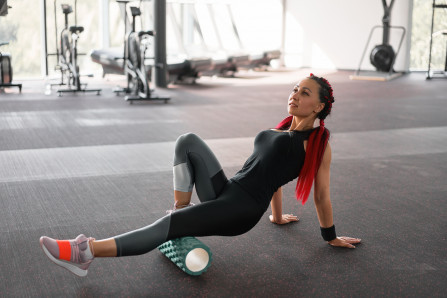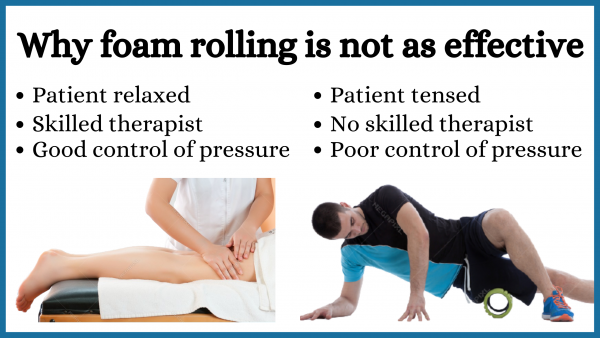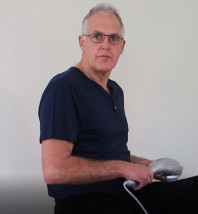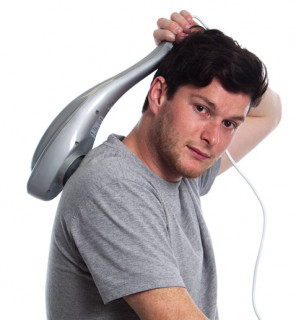Can foam rollers be harmful
Although clinical trials have shown the use of foam rollers to be safe, experts warn they can be dangerous. The reason trials show they... Read Article

In recent times it has become popular to use foam rollers as a substitute for conventional massage to help recover after sports and exercise. Advocates say that while it is not as effective it offers the advantage of practically unlimited therapy for little or no cost. However, how effective are foam rollers compared with conventional massage, and are they even safe?
Results wise, in clinical trials conventional massage is consistently is shown to reduce post exercise soreness (DOMS, or Delayed Onset Muscle Soreness) and helps speed recovery, while on the other hand the results for foam rolling are inconsistent and marginal at best. Further, in clinical trials of foam rolling patients are screened for suitability and given excellent instructions and supervision. When used unsupervised the results using foam rollers are likely to be even less, and there are some safety issues.
In this article I’ll show you the results of these trials and discuss the issues that make foam rolling so much less effective and less safe. If you do wish to use foam rollers, by taking heed of these issues you can reduce the risks of foam rolling and increase your chances of having some worthwhile benefits. However, there are better alternatives which I’ll show you.
What are foam rollers
The basics of DOMS and post exercise recovery
Massage as an aid to post exercise recovery
Foam rollers as an aid to post exercise recovery
The safer and most effective way to use foam rollers
The alternative to foam rollers
Appendix One: summary of clinical trial results of using massage for post exercise recovery
Appendix two: summary of clinical trials of the effectiveness of foam rollers
Appendix three: clinical trials of the effectiveness of vibration massage for DOMS and post exercise recovery
Professionals
References

Strenuous exercise causes microscopic damage to your muscle fibres. Your body responds by rebuilding your muscles stronger, however the damage causes temporary soreness and a reduction in the ability of your muscle to perform. The aim of recovery methods is to help reduce this soreness and help your muscles back to full function faster. Our article The practical, science based guide to post exercise recovery discusses this in more detail, including analysing the various things that help recovery and presenting a practical step by step program.

As discussed in our guide to post exercise recovery conventional massage is one of the two very useful therapies for post exercise recovery. Appendix one is a summary of clinical trials of massage for post exercise recovery. They consistently show it is a big help to reduce post exercise soreness and help your muscles faster.
As the summary of clinical trial results in appendix two show, the clinical trial results for foam rollers are no where near as good. In fact, some only show marginal benefits while others show no benefits at all.

There is a very good reason for this. As discussed in our article Do foam roller work foam rolling will not be as effective as conventional massage for three main reasons.

While clinical trial results show that foam rolling is no where near as beneficial as conventional massage, the real world results are likely to be even worse. This is because in clinical trials patients are only treated if foam rolling is appropriated, then they are given excellent instructions and supervision.
In the real world people use foam rollers on conditions they shouldn’t, and do so using less optimal and even dangerous techniques. Because of this, in chiropractic practice I quickly stopped recommending self massage using balls and rollers. For more details including some terrible advice people are given please see our article Can foam rollers be harmful.

As you can see foam rolling is very much a fad with limited benefits and a lot of risks. If you do wish to use one I’d recommend you read our article Can foam rollers be harmful so you are aware of the risks and some of the completely irresponsible and inappropriate advice commonly given, then check out our guide below on more safe usage. However, as mentioned there is a much better and safer alternative, which I’ll also discuss.
The objective of using foam rollers is to be able to provide convenient and practically unlimited massage therapy, especially before and after exercise. If done effectively and safely there are some benefits to be had, so please allow us to suggest some things you can do to get the most benefits while reducing the risks. As discussed in the section on real world usage the key safety issues are people using foam rollers on conditions that should not be foam rollered, and using foam rollers inappropriately. Because of this we ask that you get specific advice from a professional familiar with your specific needs. Given that, our general advice is as follows.
Using foam rollers on healthy uninjured muscles is relatively safe. Examples would be use as preparation for or recovery after a workout. Do not use on any injured muscles or if there is a pain syndrome unless specifically instructed to do so by a properly qualified professional.
As well as using techniques where painful pressure is applied professional therapists use very effective techniques where the muscles are squeezed. We describe this to patients as like squeezing out an old sponge. If you can use foam roller techniques that emulate these squeezing techniques rather than pressure techniques you will not only be much safer, but you will likely get better results. Pain can mean damaging tissues which is of course detrimental, plus it can stimulate the muscle to tighten which is the opposite to what you are trying to achieve.
As discussed in our article The practical, science based guide to post exercise recovery there are two main therapies that help reduce post exercise soreness and speed recovery. Those are conventional massage by a qualified therapist, and vibration massage. Like with conventional massage, clinical trials of vibration massage consistently show excellent results. I’ve summarised these in appendix three. Unlike conventional massage though, vibration massage does not need any special skills to apply and does not require you to get into any difficult positions. Because of this, if you have an appropriate massager it is usually possible to get the same excellent results using self massage. Please note though that percussion massagers (massage guns) are not vibration massagers

Using vibration massage is extra-ordinarily easy. We ask you to check our our instructions for the fine points and precautions, but basically all you need to do is place the vibration massager on the muscle over the trigger point and let the vibrations penetrate for 30-60 seconds. This can easily be repeated every day.
For how to choose an quality massager that will do a great job and that you will be extremely happy with please see our article How to choose a massager, or you can go straight and check out our economical, easy to use professional standard machines: the General Purpose Massager or our Ultimate Quad Head Massager.
Study |
What was done |
Results |
Notes |
|---|---|---|---|
Athletes were given 17 minutes massage each thigh |
Massage reduced soreness and increased jump height |
Tests were done on the fourth day of training when athletes were sore and fatigued |
|
15 minute massage just prior to exercise |
Muscle soreness, range of motion, muscle performance and blood chemical were improved 24, 48 and 72 hours post exercise |
Also tested vibration which gave equal reductions in soreness and better restoration of strength and blood chemicals |
|
15 minute calf massage post exercise |
Reduced soreness and loss of strength at 24hrs, 48 hrs & 72 hrs |
Trial also tested cold therapy which gave much poorer results |
|
30 minute thigh massage after exercise |
Reduced soreness, reduced unwanted blood chemicals and improved performance at 24, 48 and 72 hours |
||
30 minute massage on legs 2 hours after exercise |
Reduced post exercise soreness |
||
10 minute arm massage 3 hours after exercise |
Reduced post exercise soreness |
Reference |
Type of study |
Results and comments |
|---|---|---|
Review of studies |
Rolling improves flexibility, but these gains decline rapidly after rolling. Effects are not better than standard stretching |
|
Tested tenderness of Iliotibila band (ITB) after foam rolling |
Foam rolling reduced tenderness |
|
Tested foam rollers for sports recovery |
Reduced post exercise soreness (DOMS) and increased blood flow |
|
Review of 21 studies of foam rolling |
Quote: Overall, it was determined that the effects of foam rolling on performance and recovery are rather minor and partly negligible, but can be relevant in some cases (e.g., to increase sprint performance and flexibility or to reduce muscle pain sensation). Evidence seems to justify the widespread use of foam rolling as a warm-up activity rather than a recovery tool. |
|
Tested both foam roller and vibrating roller on calf muscle flexibility |
Both showed improvement |
|
Tested vibrating and non vibrating rollers for flexibility, pain and tenderness |
Vibration rollers gave better results |
|
Tested the effect of foam rollers on hamstring flexibility |
Foam rollers produced no improvement |
|
Review of 15 studies of foam rolling |
Review of 15 studies of foam rolling Could not conclude any optimal program |
|
Tested effects of foam rollers on knee range of movement |
The massage was painful, but increased range of movement |
|
Review of 75 studies and other scientific papers |
Poor and conflicting evidence of any benefits, plus concern about potential risks. |
|
Review of 9 studies of foam rolling |
If used before or after exercise it can reduce soreness |
Study |
What was done |
Results |
Notes |
|---|---|---|---|
Used 55Hz but only 0.9mm amplitude (way too small) |
Showed no improvement |
The researches should have read our article on how to choose a massager |
|
5 minutes of 50 Hz massage just prior to exercise |
Muscle soreness, range of motion, muscle performance and blood chemical were improved 24, 48 and 72 hours post exercise |
Also tested massage which gave equal reductions in soreness but less restoration of strength and blood chemicals |
|
5 minutes of 60 Hz vibration to biceps before or after exercise |
Both reduced soreness and unwanted blood chemicals 24, 48 and 72 hours after. |
Vibration before exercise gave the biggest improvement |
|
30-50 Hz vibration applied to quads and calf muscles before exercise |
Reduced pain 24 hours after exercise |
||
30 minute vibration treatment to arm after exercise then 1,2,3 and 4 days after |
Reduced soreness and faster recovery |
||
1 minute application of 50 Hz vibration to quadriceps before exercise |
Reduced soreness and unwanted blood chemicals |
||
Home therapy with an electrical device claimed to deliver 28-85 Hz vibration to muscles |
Reduced soreness and increased strength |
Supported home use |
|
20 Hz for 20 min to biceps after and 2 days after exercise |
Decreased soreness and increased blood flow |
DrGraeme massagers were originally built by Dr Graeme for use in his clinic, and to prescribe to his patients for additional self use at home. Now these are used by colleagues and other professionals for similar purposes. If you are a professional and wish to know more about this therapy, or possibly get a sample massager to trial please check out our practitioner page.
We are continually adding more information on research and uses. Subscribe below to have us email them to you "hot off the press".

Several years ago Dr Graeme, a Chiropractor practicing in Victoria, Australia was looking for a serious hand held massager his patients could use at home to get the extra quality massage they needed. The ones he found in the shops and on-line for home use looked nice but were not serious, and... read more
Although clinical trials have shown the use of foam rollers to be safe, experts warn they can be dangerous. The reason trials show they... Read Article
Vibration massage is an excellent therapy. However, too many massage guns fail to deliver this because: they use percussion which is less... Read Article
Most professional athletes and sports clubs make heavy use of massage type treatments. The ability to do self massage using a hand held... Read Article
Vibration massage is an excellent therapy. However, too many massage guns fail to deliver this because: they use percussion which is less... Read Article
As a chiropractor for over 27 years vertebral subluxation complexes are a very real problem that can cause pain, long term spinal damage... Read Article
Do not refresh or leave this page until loading complete.